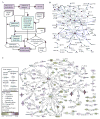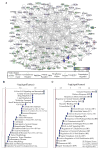Effects of tobacco smoke on gene expression and cellular pathways in a cellular model of oral leukoplakia
- PMID: 19138943
- PMCID: PMC3773527
- DOI: 10.1158/1940-6207.CAPR-08-0007
Effects of tobacco smoke on gene expression and cellular pathways in a cellular model of oral leukoplakia
Abstract
In addition to being causally linked to the formation of multiple tumor types, tobacco use has been associated with decreased efficacy of anticancer treatment and reduced survival time. A detailed understanding of the cellular mechanisms that are affected by tobacco smoke (TS) should facilitate the development of improved preventive and therapeutic strategies. We have investigated the effects of a TS extract on the transcriptome of MSK-Leuk1 cells, a cellular model of oral leukoplakia. Using Affymetrix HGU133 Plus 2 arrays, 411 differentially expressed probe sets were identified. The observed transcriptome changes were grouped according to functional information and translated into molecular interaction network maps and signaling pathways. Pathways related to cellular proliferation, inflammation, apoptosis, and tissue injury seemed to be perturbed. Analysis of networks connecting the affected genes identified specific modulated molecular interactions, hubs, and key transcription regulators. Thus, TS was found to induce several epidermal growth factor receptor (EGFR) ligands forming an EGFR-centered molecular interaction network, as well as several aryl hydrocarbon receptor-dependent genes, including the xenobiotic metabolizing enzymes CYP1A1 and CYP1B1. Notably, the latter findings in vitro are consistent with our parallel finding that CYP1A1 and CYP1B1 levels were increased in oral mucosa of smokers. Collectively, these results offer insights into the mechanisms underlying the procarcinogenic effects of TS and raise the possibility that inhibitors of EGFR or aryl hydrocarbon receptor signaling will prevent or delay the development of TS-related tumors. Moreover, the inductive effects of TS on xenobiotic metabolizing enzymes may help explain the reduced efficacy of chemotherapy, and suggest targets for chemopreventive agents in smokers.
Figures



Comment in
-
Genomics of smoking exposure and cessation: lessons for cancer prevention and treatment.Cancer Prev Res (Phila). 2008 Jul;1(2):80-3. doi: 10.1158/1940-6207.CAPR-08-0047. Epub 2008 Mar 31. Cancer Prev Res (Phila). 2008. PMID: 19138939 No abstract available.
References
-
- Gritz ER, Dresler C, Sarna L. Smoking, the missing drug interaction in clinical trials: ignoring the obvious. Cancer Epidemiol Biomarkers Prev. 2005;14:2287–2293. - PubMed
-
- Hecht SS. Tobacco carcinogens, their biomarkers and tobacco-induced cancer. Nat Rev Cancer. 2003;3:733–744. - PubMed
-
- Mayne ST, Lippman SM. Cigarettes: a smoking gun in cancer chemoprevention. J Natl Cancer Inst. 2005;97:1319–1321. - PubMed
-
- The Alpha-Tocopherol, Beta Carotene Cancer Prevention Study Group. The effect of vitamin E beta carotene on the incidence of lung cancer and other cancers in male smokers. N Engl J Med. 1994;330:1029–1035. - PubMed
Publication types
MeSH terms
Substances
Grants and funding
LinkOut - more resources
Full Text Sources
Molecular Biology Databases
Research Materials
Miscellaneous

